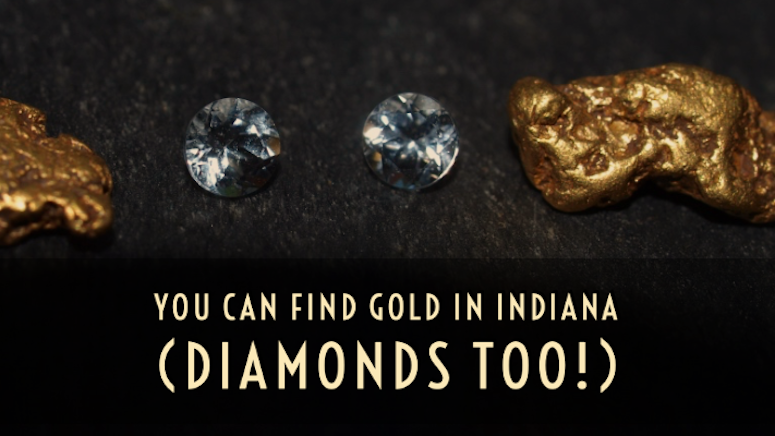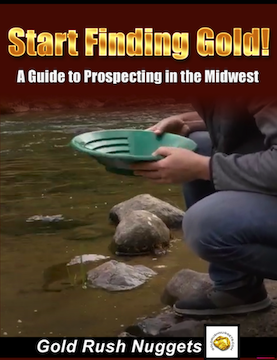
In the 19th century, there were exciting gold rushes occurring throughout the Western US. As the song says: “Go west young man! Haven’t you been told? California’s full of whiskey, women and gold!”
But Indiana? Not so much. Few found Indiana to be a favorable place for gold prospecting, and most ventured onward in search of richer ground.
Still to this day, the state lacks any large scale gold mines, which cements the belief there isn’t much gold here to be found. Truth be told, there is gold here. In fact, there are a wide array of valuable minerals ranging from gold to perhaps the most coveted gemstone of them all… diamonds. Yes, Indiana hides more treasures than most realize.
Diamonds & Gold… but where?
Once in a while, we hear someone has found gold nuggets or a small piece of diamond. Recorded discoveries of both minerals date back centuries, and such news keeps the hopes of fortune seekers alive.
But without any record of large scale mining in the past, prospectors have very little information on places to look. Many prospectors who had luck in the past remained tight-lipped about the locations.
That said, if you look hard and long enough, you also can find gold and diamonds in Indiana. Plus, you’re not completely in the dark. From the little information gathered from past prospectors, here are the best places to find gold and diamonds in the state.
Gold Prospecting and Panning in Indiana
Like its neighboring states, Indiana has gold brought by glacial deposits that originated to the north in Ontario, Canada. Pretty much the entire Midwest has at least a little bit of gold… the trick is finding it. The progression of glaciers to the south may have brought gold, diamonds and other minerals along for the ride, but that doesn’t mean that it’s going to be easy to find.
Natural gold veins are absent in Indiana. No one has seen or heard of lode gold in these parts of the United States. Prospectors should look for flour and placer gold deposits. Rarely is the gold of any substantial size, most often you are on the lookout for “dust.” Tiny specks, an occasional crumb, maybe a “picker,” and the occasional rare chunky nugget.
Gold deposits are going to concentrate by the flow of water, so it’s best to carry a sluice box along with the panning equipment and search the creeks and rivers. There are a few noteworthy areas to explore.
In the past, recreational prospectors have tasted success in the streams and creeks of Brown County. A fair amount of gold was discovered in Salt Creek. The major portion of the gold found in Salt Creek was glacial gold stored in gravel and gravel bars. The creek is also the best place to find small gold nuggets, which are rare and certainly not found often.
If you’re really lucky, you’ll find gold nuggets in the crevices of the creek that’s fed by water flowing from northern Brown County and Sweetwater Lake.
In Indiana, streams and creeks are the ideal places to look for gold. The Monroe County has many of them, of which the most famous ones among gold prospectors are Sycamore Creek, Gold Creek, and Indian Creek. Practice your best panning technique if you’re at the Sycamore Creek because the gold found here is very fine and it’s mainly found in the gravel deposits in the banks.
Gold-bearing gravel is also known at Greenhorn Creek and Morgan County. Gold prospectors around the Johnson County must check out Highland Creek. Stream sandbars and gravel deposits store some glacial gold.
A good sluice box will come handy for those around Warren County. Prospectors have a good chance of finding the yellow metal in Falls Creek. Bear in mind that the gold here is fine, but you might also find some grain and flake sized gold deposits in the shale beds and gravel bars in the creek.
Wayne County is another area that has proved productive to gold prospectors in the past. Prospectors have found picker and glacial gold in Nolands Fork Creek.
Although Indiana isn’t blessed with large deposits of gold, every creek and stream is a potential source of the yellow metal. Many streams zigzag through the state and most any of them are worth doing a test pan to see if you can find any color. The terminal moraines left from receding glaciers are the indicator to look for. Gold could be literally anywhere. You just have to find it.
Other notable locations include the Wabash River, Silver Creek, and 14 Mile Creek (both in Clark County).
Diamond Mining in Indiana
Most prospectors know that glacial gold is scattered across the Midwest, but the presence of diamonds are another matter entirely.
Like gold, diamonds do not naturally occur in the state. Not to be confused with a genuine diamond deposit such as at Crater of Diamonds Park in Arkansas, the diamonds in Indiana were brought there through glaciation. And just like the gold, they can be very hard to find.
There have actually been multiple diamonds ranging up to 21 carats throughout Indiana, Wisconsin and Ohio. While the origin of these is most certain to be Ontario, Canada, the exact location of the source is unknown to this day. Some theorize that the source could even be in Michigan or Minnesota.
Brown County is a go-to place for fortune seekers of gold and diamond. Diamonds up to 5 carats have been found near Morgantown, particularly in Lick Creek. Some of the other places in Morgantown to try your luck are Goss Creek, which is an offshoot of Little Indian Creek. Diamonds of 3 carats or higher can also be found in the Little Indian Creek and Gold Creek.
The obvious locations to look for diamonds are the creeks, streams, and other water sources just as you would for gold. The creek beds of Indiana could actually hold a wide variety of precious stones. There are still many creeks in the state that haven’t been fully prospected.
Look for water sources that drain through potential prospecting areas. Study and learn to identify areas of past glaciation. This will be your best indicator for the better spots to start your search. Yes, there is most certainly still gold and even diamonds left waiting to be found in Indiana.

